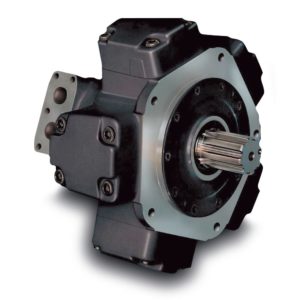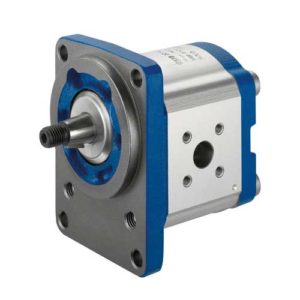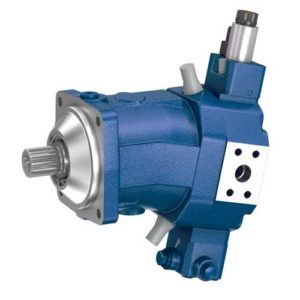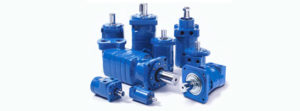The ultimate guide to hydraulic motors
There are many different types of hydraulic motor. Most of them can be categorised as: axial piston motors, radial piston motors, hydraulic gear motors or hydraulic vane motors.
Unlike a linear, force-moving cylinder, the hydraulic motor uses hydraulic pressure to rotate. A hydraulic motor is built very much like a pump. However, when operated, oil enters the hydraulic motor and turns the shaft. The amount of oil supplied by the hydraulic pump determines the speed of a hydraulic motor. Subsequently, the torque is dependent on the amount of pressure supplied.
Learn about radial piston motors
Radial piston motors are highly efficient and generally have a long life. Furthermore, they provide high torque at relatively low shaft speeds, as well as excellent low speed operation with high efficiency. The low output speed means that, in many cases, a gearbox is not necessary. 
Radial piston motors are often referred to as LSHT – Low Speed High Torque motors. We supply radial piston motors from brands worldwide, including Bosch Rexroth, Staffa (Kawasaki) and the Italgroup.
Which applications are radial piston motors commonly found in?
Radial piston motors are commonly fund in: excavators, cranes, ground drilling equipment, winch drives, concrete mixers, trawlers and plastic injection moulding machines.
Which types of radial piston motors are there?
Generally, there are two basic types of radial piston motors. These are explained further here.
Crankshaft radial piston motor
The Crankshaft radial piston motor has a single cam and pistons pushing inwards. Moreover, it has an extremely high starting torque and is available in single displacements from 40 cc /rev through to about 5400 cc/rev. In addition, the Crankshaft type radial piston motors can run at “creep” speeds. And, some can run seamlessly up to 1500 rpm with virtually constant output torque. To sum up, the Crankshaft radial piston motor is the most versatile hydraulic motor.
Multilobe cam ring design
This type is constructed with a cam ring, which has multiple lobes and piston rollers that push outwardly against the cam ring. In essence, this produces a very smooth output with high starting torque. However, they are often limited in the upper speed range. Moreover, these high power motors are particularly good on low speed applications.
Other types of radial piston motors include: compact radial piston motors, dual displacement radial piston motors and fixed displacement radial piston motors. And in addition, we can also help you source: low speed high torque radial piston motors, two speed radial piston motors and variable displacement radial piston motors.
How do hydraulic gear motors work?
Gears are used to reduce the shaft output speed for applications that require a lower speed. This means that the gear motor’s operating pressure typically is very low, ranging between 100 and 150 bar. In addition, some of the more modern gear motors operate at, up to, 250 bar continuous pressure. However, the downside is that this motor can be rather noisy. 
To sum up, gear motors are generally lightweight and small units with relatively high pressures. In addition they are known for their low cost, variety of speeds, broad temperature range, simple design and large viscosity range.
About hydraulic vane motors
Hydraulic vane motors are used in both industrial and mobile applications. For example, screw-drive, injection moulding and agricultural machinery. These motors tend to have less internal leaking than a gear motor. And subsequently, they are better to use in applications requiring lower speeds. 
Hydraulic vane motors feature reduced noise level, low flow pulsation, high torque at low speeds and a simple design. Moreover they are easy to service and suitable for vertical installation. To function correctly, the rotor vanes must be pressed against the inside of the motor housing. This can be done through spiral or leaf springs. But rods are also suitable.
A vane motor typically features a displacement volume between 9 cc/rev to 214 cc/rev and a maximum 230 bar pressure. The speeds range from 100 to 2,500 rpm. Maximum torque of up to 650 Nm.
Learn more about axial piston motors
Axial piston motors use a bent axis design or a swash plate principle. The fixed displacement type works as a hydraulic motor and can be used in open and closed circuits. In contrast to this, the variable displacement type operates like a hydraulic pump. 
In the bent axis design, pistons move to and fro within the cylinder block bores. This movement is converted into rotary movement via the piston ball joint at the driving flange. In the swash plate design, pistons move to and fro in the cylinder block. Subsequently it revolves and turns the drive shaft via the connected cotter pin.
What are the main characteristics of a gerotor motor?
Low speed, high torque (LSHT) hydraulic Gerotor motors feature a high starting torque and large range of speeds with a continuous output torque. In addition, the motor has a good power-to-weight ratio and a smooth operation, even at low speeds. The Gerotor motor’s design is furthermore very robust and built for harsh working conditions. 
Frequently asked questions and answers about Hydraulic Motors
Which hydraulic motor brands do you provide?
We have direct access to over 80 leading hydraulic brands. This means that we offer agile and flexible solutions to suit every customer’s budget, lead-time and specifications. Our bestselling brands include: Bosch Rexroth motors, Danfoss motors, Eaton Char-Lynn motors, Italgroup Radial Piston motors, Parker Hannifin motors and Vivolo Vivoil motors.
Our team will work closely with you to advise on the best hydraulic motor for your system and application.
Can you get hold of the exact same motor that we’re already using?
Yes, if you have the manufacturer’s name and product number, we can source any motor still listed in the market. Furthermore, if the motor is now obsolete, our skilled team can source direct equivalents. In some instances, this means better lead-times and reduced cost.
Do you manufacture custom-made hydraulic motors?
We do not manufacture our own motors. However, we have excellent relationships and direct access to 80 leading hydraulic brands. This means that we can source a hydraulic motor, which meets your exact requirements. In addition, we can help with in-house bespoke cylinders or bespoke power pack builds.
Do you ship worldwide?
Yes! Today we export to 130 countries worldwide and are, in the UK, viewed as the hydraulics solutions “gateway” to the rest of the world. Moreover, in 2019, UK’s Department for International Trade appointed Hydraulics Online as a Northern Powerhouse Export Champion. If it’s hydraulic we can design it, supply it, solve it, repair it and ship it worldwide!
Do you repair motors?
Yes, we repair piston motors and vane motors. Our technical engineers can give a full diagnosis and will contact you to discuss all options available. More importantly, they can identify the best solution for your specific needs. And if applicable, our team offers recommendations on how to future-proof your motor’s performance. Above all, this saves costs and prevents further system downtime.
Hydraulic Motor Glossary
Need more information? Then please get in touch on +44 (0)845 6443640.
Motor displacement
This equals the fluid capacity required to turn the motor output shaft through one revolution. A hydraulic motor usually has a in.3 or cm3 per revolution displacement. Moreover, the hydraulic motor displacement is either fixed or variable. A fixed-displacement motor delivers continuous torque. Controlling the input flow amount varies the speed. A variable-displacement motor, on the other hand, offers variable torque and variable speed. Displacement variation alters the torque speed ratio to meet load requirements.
Torque output
Torque output is conveyed in inch-pounds or foot-pounds. It measures the precise pressure drop across the motor.
Breakaway torque
The torque required to get a stationary load turning. More torque is required to start a load moving than to keep it moving. Running torque can refer to a motor’s load or to the motor. When it refers to a load, it indicates the torque required to keep the load turning.
Running torque
This can refer to a motor’s load or to the motor itself. When it refers to a load, it specifies the torque needed to ensure the load keeps turning. When it refers to the motor, it identifies the actual torque that a motor can reach to keep a load turning. Running torque takes into account a motor’s inefficiency and is a percentage of its theoretical torque.
Starting torque
This refers to a hydraulic motor’s capacity to start a load. It indicates the amount of torque that a motor can reach to start a load turning. In some cases, this is significantly less than the motor’s running torque. In addition, starting torque can be displayed as a percentage of hypothetical torque. Starting torque for common gear, vane, and piston motors varies between 70% and 80% of hypothetical.
Mechanical efficiency
This is the ratio of actual torque delivered to theoretical torque.
Torque ripple
This is the difference between minimum and maximum torque distributed at a certain pressure and during the hydraulic motor’s one revolution.
Motor speed
Is a function of motor displacement and the fluid volume transported to the motor.
Maximum motor speed
This is the motor’s maximum tolerated speed at a particular inlet pressure for a limited time without damage.
Minimum motor speed
This is the motor’s output shaft slowest, non-stop, uninterrupted rotational speed available.
Slippage
Slippage is the motor leakage, or the fluid, that flows through the motor without accomplishing work.
You can find more information within our Technical Knowledge Hub and hydraulics glossary list.





